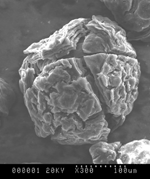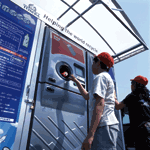
PCT Portraits: Eco-Inventors
More than 1.2 million international patent applications covering new technology of every description have been filed since the Patent Cooperation Treaty (PCT) began operating in 1978. Continuing our series of snapshots, WIPO Magazine seeks out the people behind the patents. In this edition, inventions by a Chinese-Canadian chemical engineer, an American construction worker and two Norwegian brothers from the supermarket business put waste to work for a greener planet.
Not afraid of the big bad wolf
People react differently to bad news. When David Ward, a former construction worker from Oregon, in the U.S., was told by his doctor that exposure to building materials had made his "blood chemistry read like a list of industrial solvents," he did not retire or seek redress, but rather set about finding a less harmful way to build homes.
Knowing that traditional bricks of mud mixed with plant fiber were an effective building material, he began to investigate ways of using straw, an agricultural waste product, to construct building panels. This in itself was not new. Industrial processes already existed to produce compressed straw building blocks. David Ward’s creative vision was to move the process from the factory to the field. This not only cut out factory overheads. By using uncut, uncrushed straw straight from the field, he greatly increased the strength of the resulting composite.
By December 2002, with the help of the Oregon State University and a grant from the Environmental Protection Agency, David Ward had completed and field-tested his first StrawJet combine-harvester. This produces as "waste" a continuous, five centimeter diameter straw cable, held together with a clay and paper-pulp bonding agent. In the next stage a "loom truck" weaves the cable into mats, and then into strong construction panels. Mr. Ward has formed a non-profit corporation, the Ashland School of Environmental Technology, to take forward the project. His PCT application for the StrawJet Harvester was published this year.
It has taken Mr. Ward 13 years to get this far. "At times," he admitted, "I was pretty sure it was never going to work." But perseverance paid off, and the StrawJet project is gaining wide recognition after winning the 2006 Modern Marvel of the Year award from the U.S. National Inventors Hall of Fame.
The Strawjet technology aims to serve both developed countries as an ecologically sustainable building material, as well as developing countries, where straw or other plant fiber by-products (such as palm fronds or hemp) could provide a plentiful and cheap alternative to conventional materials.
For more see: www.greeninventor.org/strawjet.shtml
________________________
Treating Waste with Waste

“To me, this is one of the most beautiful pictures.” Professor Jia's scanning electron microscope image of an ECOcarbon particle produced from oil-sand waste. (Courtesy C. Jia).
Oil-sand deposits are an important source of crude oil in Canada and Venezuela. But the potential environmental cost of exploiting them is high. The extraction process can leave behind noxious waste products; and for every barrel of synthetic oil produced from oil-sands in Alberta, Canada, more than 80 kg of greenhouse gases are released into the atmosphere.
Enter Professor Charles Jia - a chemical engineer from China and expert in the environmental applications of sulfur chemistry, now at the University of Toronto in Canada. With his colleague, Professor Don Kirk, he developed the SOactive process, which uses sulfur-dioxide to convert oil-sand fluid coke into active ECOcarbon, and to remove mercury from industrial waste.
"Our biggest problem," Professor Jia told WIPO Magazine, "was the common belief that a waste is a waste. No-one believed that the oil-sand fluid coke, a solid with a dense, layered structure, could be activated." He and Professor Kirk are now securing funding to field-test the effectiveness of SOactive and ECOcarbon in removing mercury at the site of a company that emits both mercury and sulfur in its industrial waste.
The professors themselves drew up the draft patent application and claims before getting them finalized by a patent attorney. "For me it was a learning process," comments Professor Jia, "and quite demanding in time and money." Their PCT application was published in 2003.
________________________
Cashing in on Trash

TOMRA has installed 50,000 reverse vending machines worldwide to encourage the recycling of beverage containers.(Courtesy of TOMRA)
There are estimated to be some 700 billion plastic drinks containers, bottles and cans in circulation in the world, the majority of which still end up in landfill sites. The raw materials and energy consumed in manufacturing ever more bottles exacerbates the depletion of natural resources. In Norway, however, consumers now return 90 percent of their used drinks containers to supermarkets for recycling in return for a cash refund. The success of the Norwegian effort was made possible in part by the ingenuity of two brothers, Petter and Tore Planke, the founders of TOMRA.
Their story began in 1971, when the owner of one of Oslo’s biggest supermarkets sought their help: The Norwegian government required shops to refund customers for empty bottles, but supermarkets were unable to cope with the quantities. They needed some kind of automated processing system. Within a year the brothers had devised a prototype "reverse vending machine," containing a single hole for the return of all types of bottles, and a printer to issue receipts for the amount of the refund due. Tore Planke filed their first patent with the Norwegian Patent Office in December 1971.
From there, the brothers began to develop new products and processes covering the whole process from bottle collection to delivery to the recycling point. Thirty-four years on, TOMRA is a market leader in reverse vending machines for glass and plastic bottles and cans. Under the slogan, Helping the world recycle, the company has installed 50,000 machines on four continents.
The company has more than 30 PCT applications, which cover devices for lifting, rotating and conveying empty bottles, as well as sophisticated image recognition technology to identify different sorts of containers. Maintaining the patents is expensive. But, says TOMRA’s chief scientist, Andreas Nordbryhn, without patent rights, "you have no way to calculate the possible losses if you run into problems. It is a lot like insurance. Who would run a business today without appropriate insurance?"
For more see: www.tomra.com
Elizabeth March, WIPO Magazine Editor, Communications and Public Outreach Division
________________________
The WIPO Magazine is intended to help broaden public understanding of intellectual property and of WIPO’s work, and is not an official document of WIPO. The designations employed and the presentation of material throughout this publication do not imply the expression of any opinion whatsoever on the part of WIPO concerning the legal status of any country, territory or area or of its authorities, or concerning the delimitation of its frontiers or boundaries. This publication is not intended to reflect the views of the Member States or the WIPO Secretariat. The mention of specific companies or products of manufacturers does not imply that they are endorsed or recommended by WIPO in preference to others of a similar nature that are not mentioned.